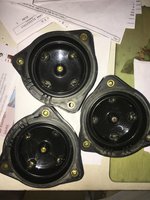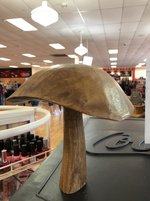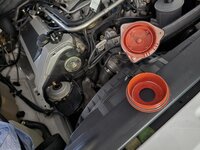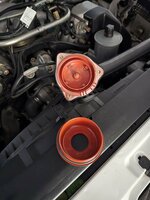Hi, sorry to revive an old thread, but I´ve read it all and tried the suggested procedures without success. Car is a 1993 R129 with 119 engine and 722 trans. It has almost 8000 km on it and it´s in mint condition. The car have had this missfire a while ago and in the past, they´ve tried to solve it changing distributor rotors, caps, isolators, engine wiring harness, modules, coils, fuel pump, and the list of throwed parts goes on...
Ouch. Most of those parts should not have needed replacement with only 8000 km's.

The engine behavior is erratic, like it has missfires on different cylinders and sometimes it just die. The idle quality is poor too. If I hit the gas pedal on a steady position (ie 4k rpm) for some brief moments in time, the engine runs perfect, but the missfire appears again and again, it´s kind of hard to explain in words, but think on it like having a 2-3 cylinder kill switch and toggle it on/off constantly. The isue is present on cold and hot engine but it gets a little worse when hot.
Does the engine ever run smoothly on all 8 cylinders? Have the fuel injectors been tested / cleaned? With only 8kkm in 30 years, the car may have had stale fuel for years at a time.
I´m not a mercedes expert and this platform is new to me. I´ve started getting the 38 pin diagnostic port codes with the test 3 pin cable tester I custom made for it, and after clearing it all, the following codes reappeared:
See notes below:
Pin 4 LH-SFI Codes 7 (TN-signal / rpm signal - incorrect or open/short circuit)
This is an odd / unusual fault code. If this keeps recurring, something may be up with the RPM signal.
Pin 4 LH-SFI Codes 9 (Starter signal (circuit 50) missing, open/short circuit)
Yet another odd fault code. See if this recurs after being cleared.
Pin 6 ABS Code 30 (CAN data bus to E-GAS control module (N4/1), interrupted)
This is a "ghost code", it can typically be ignored. This code will appear any time "limp mode" occurs. Note that limp mode will be triggered if you operate the throttle linkage behind the airbox! Do not try to rev the engine from the linkage behind the airbox, this will trigger limp mode every time and store erroneous fault codes.
Pin 7 EA ISC CC Code 03 (Various faults related to ETA / throttle actuator)
Pin 7 EA ISC CC Code 07 (CAN databus: messages faulty)
Pin 7 EA ISC CC Code 14 (Closed throttle position switch (S29/3)
See if any of these code return after you have cleared them. You may have a faulty ETA, the wiring may be disintegrating.
Pin 8 BM BAS Code 06 (A/C electromagnetic clutch (A9k1) jammed or poly-V-belt broken.)
This code occurs when the RPM signals do not match between engine and AC compressor. It could be related to the TN/RPM signal fault.
Pin 17 DI / EZL Code 12 (TN-signal (engine rpm output) is outside of tolerance range)
This is another odd fault code.
I´ve tested the CPS resistance, around 850 cold and near 1k ohm hot. re-torqued it was little loose but no improvement on the described problem.
Sounds normal. The crank sensor is original / OE, correct? It should be fine, I would not replace it.
I´ve tested the Cam sensor, little above 1k ohm hot. I let it cool down but never saw it below 1k This sensor was changed, not OEM.
I'd re-install the original / OE cam position sensor (if available), the aftermarket ones are all Chinese. This is very unlikely to be causing your problems though.
As you can see in the pictures, I´ve cleaned the distributor rotor caps and insulators on both sides. It had some moisture mainly on the rear part between the insulator and cam seal. The missfire stays the same.
There is some light carbon-tracking visible on the caps, indicating a misfire of some sort. You should also add additional vent slots into the new caps as described in
this thread. I also see a trace of engine oil at the lower edge of both caps, but I don't think that's the root cause of what you are currently dealing with.
I plan to take out the spark plugs. What if they´re not low resistance ones? Can it be the issue?
Unless the plugs are physically damaged or otherwise faulty, no, this should not cause the problem. The "wrong" spec plugs would not cause this type of misfiring. However, you should verify they are correct non-resistor F8DC4 or equivalent, and set the gap to 1.0mm (larger than spec of 0.8mm). Verify there is no engine oil leaking from the valve cover gasket into the plug wells. Oil on the threads is normal but there should not be oil on the hex flats or insulator. Also see if the spark plugs have a normal light brown / tan color on the insulator. The insulator should not be black or oily. And, all 8 plugs should look similar.
ALSO, measure each spark plug boot for resistance, normal is 1600-2400 ohms... if any measure significantly higher (say, 5k-10k ohms or more) that boot is faulty. You can look for arcing under the hood at night, if any wires are arcing to ground, replace the wire set (with Beru, details
here). Don't replace the wires unless you confirm they are faulty.
Also, there are 2 engine management codes related to RPM. Can it be the camshaft position sensor? Is there any other engine RPM related sensors on this engine?
This is very unusual, and if these codes keep returning after you clear them, you need to investigate further until you can correct this problem. This is NOT related to the camshaft position sensor. The engine RPM signal is from the crankshaft sensor, located below the driver side cylinder head (behind cyl #8), on the upper transmission bellhousing area. The crank sensor (CKP) connects to the EZL. There are 2 magnets on the flywheel which trigger the sensor.
What else should I look for?
1) After clearing all of the codes above, and driving the car, which codes appear after the misfire occurs? Codes do not clear on their own, if never checked, some codes could be from many years ago and irrelevant to your current faults.
2) Has the transmission ever been removed from this car, and was ANY work done just before the misfiring problems began?
3) Take a photo of the EZL part number, and remove the CAN box and take a photo of the modules in the CAN box (especially LH and E-GAS). We need to verify all those part numbers are correct.
4) For grins, try disconnecting the MAF and see if the engine runs the same, better, or worse. If it runs better, your MAF could be defective. I really doubt it, but this is an easy test.
5) For more detailed diagnostics you really need live data (see the video in
this post). If you can view live data while the misfire is occurring, it will identify the exact cylinders which are at fault, which may help point you in the right direction. You can also verify the MAF airflow readings are accurate, and verify the LH adaptation values are not near maximum (indicating a mixture issue). Do you know anyone that could connect SDS with HHT-Win to your car, to view the live data? Alternately, you can buy this for ~$600 USD or so, it will work on most all Mercedes from early 90's and newer.
6) What brand distributor caps & rotors were installed? It's possible to have defective new parts out of the box... this is rare, but it's happened to more than one forum member over the years. This would not cause the TN/RPM fault code though.
7) If you keep getting the ETA-related faults on the E-GAS module, your ETA may need a rebuild (the internal wiring can have the insulation fall off). I wouldn't replace the ETA, the internal pots/switches/clutch should be brand new (8kkm!), only the wiring needs to be repaired.











